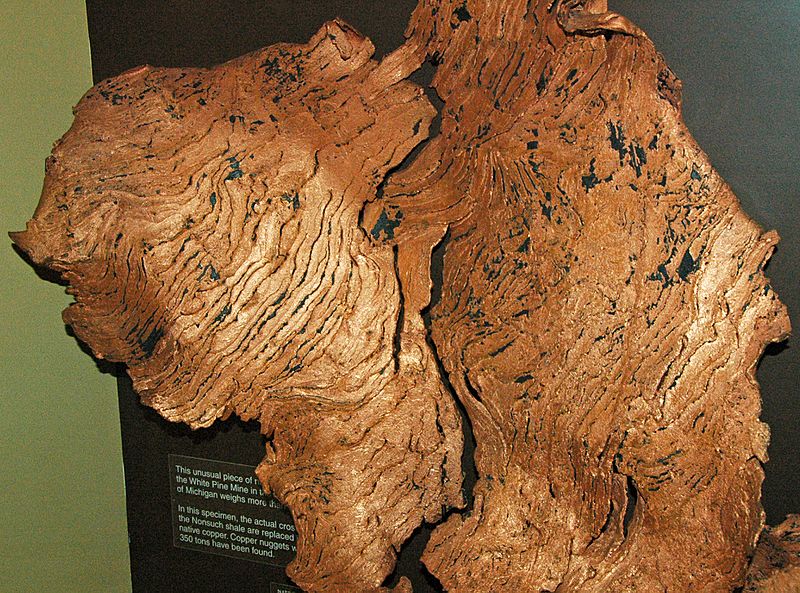Image: Native copper-replaced cross-bedded sedimentary rocks (Nonesuch Shale, Mesoproterozoic; White Pine Mine, Upper Peninsula of Michigan, USA) 1 (17110279879)

Description: Native copper-replaced cross-bedded sedimentary rocks from the Precambrian of Michigan, USA. (CMNH 20309, Cleveland Museum of Natural History, Cleveland, Ohio, USA) A mineral is a naturally-occurring, solid, inorganic, crystalline substrance having a fairly definite chemical composition and having fairly definite physical properties. At its simplest, a mineral is a naturally-occurring solid chemical. Currently, there are over 4900 named and described minerals - about 200 of them are common and about 20 of them are very common. Mineral classification is based on anion chemistry. Major categories of minerals are: elements, sulfides, oxides, halides, carbonates, sulfates, phosphates, and silicates. Elements are fundamental substances of matter - matter that is composed of the same types of atoms. At present, 118 elements are known (four of them are still unnamed). Of these, 98 occur naturally on Earth (hydrogen to californium). Most of these occur in rocks & minerals, although some occur in very small, trace amounts. Only some elements occur in their native elemental state as minerals. To find a native element in nature, it must be relatively non-reactive and there must be some concentration process. Metallic, semimetallic (metalloid), and nonmetallic elements are known in their native state as minerals. Copper is the only metallic element that has a "reddish" color - it’s actually a metallic orange color. Most metallic elements, apart from gold & copper, are silvery-gray colored. Copper tends to form sharp-edged, irregular, twisted masses of moderately high density. It is moderately soft, but is extremely difficult to break. It has no cleavage and has a distinctive hackly fracture. The unbelievable copper specimen shown above comes from northern Michigan's White Pine Mine, which is developed in the Precambrian-aged Nonesuch Shale (~1.07 to 1.08 Ga). At this mine, native copper is usually encountered filling fractures (joints). This large, 70-pound specimen represents actual sedimentary rock that has been replaced by native copper. The irregular layers are crossbeds, which formed as the original sediments were deposited by a one-directional current. The small black-colored patches are bits of the unaltered sedimentary host rock. White Pine Mine copper mineralization occurred at 1.05 to 1.06 billion years ago. Stratigraphy: lower Nonesuch Shale (near the contact with the Copper Harbor Conglomerate), late Mesoproterozoic, ~1.07-1.08 Ga Locality: near the southwestern shaft at the 2500 foot level, White Pine Mine, Upper Peninsula of Michigan, USA
Title: Native copper-replaced cross-bedded sedimentary rocks (Nonesuch Shale, Mesoproterozoic; White Pine Mine, Upper Peninsula of Michigan, USA) 1 (17110279879)
Credit: Native copper-replaced cross-bedded sedimentary rocks (Nonesuch Shale, Mesoproterozoic; White Pine Mine, Upper Peninsula of Michigan, USA) 1
Author: James St. John
Usage Terms: Creative Commons Attribution 2.0
License: CC BY 2.0
License Link: https://creativecommons.org/licenses/by/2.0
Attribution Required?: Yes
Image usage
The following page links to this image:

